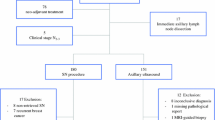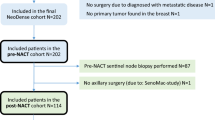Abstract
Background
As tumor biology takes precedence over anatomic staging to determine breast cancer (BC) prognosis, there is growing interest in limiting axillary surgery. There is a need for tools to identify patients at the lowest risk of harboring axillary lymph node (ALN) disease, to determine when omission of sentinel lymph node biopsy (SLNB) may be appropriate. We examined whether a nomogram using preoperative axillary ultrasound (axUS) findings, clinical tumor size, receptor status, and grade to calculate the probability of nodal metastasis (PNM) has value in surgical decision making.
Methods
This was a retrospective analysis of female patients (February 2011–October 2014) with invasive BC who underwent preoperative axUS and axillary surgery. Cases with locally advanced BC, neoadjuvant treatment, or bilateral BC were excluded. PNM was calculated for each case. Using various PNM thresholds, the proportion of cases with ALN metastasis on pathology was examined to determine an optimal PNM cut-point to predict ALN negativity.
Results
Of 357 included patients, 72% were node-negative on surgical staging, and 69 (19.6%) had a PNM < 9.3%. Of these 69 patients, 6 had ALN metastasis on surgical pathology, yielding a false negative rate (FNR) of 8.7% for predicting negative ALN when a PNM threshold of < 9.3% was used.
Conclusion
A nomogram incorporating axUS findings and tumor characteristics identified a sizeable subgroup (19.6%) in whom ALN was predicted to be negative, with an 8.7% FNR. Surgeons can use this nomogram to quantify the probability of ALN metastasis and select patients who may benefit from omitting SLNB.

Similar content being viewed by others
References
DiSipio T, Rye S, Newman B, Hayes S. Incidence of unilateral arm lymphoedema after breast cancer: a systematic review and meta-analysis. Lancet Oncol. 2013;14(6):500–15.
Lucci A, McCall LM, Beitsch PD, et al. Surgical complications associated with sentinel lymph node dissection (SLND) plus axillary lymph node dissection compared with SLND alone in the American College of Surgeons Oncology Group trial Z0011. J Clin Oncol. 2007;25(24):3657–63.
Fisher B, Jeong J-H, Anderson S, Bryant J, Fisher ER, Wolmark N. Twenty-five-year follow-up of a randomized trial comparing radical mastectomy, total mastectomy, and total mastectomy followed by irradiation. N Engl J Med. 2002;347(8):567–75.
Hughes KS, Schnaper LA, Bellon JR, et al. Lumpectomy plus tamoxifen with or without irradiation in women age 70 years or older with early breast cancer: long-term follow-up of CALGB 9343. J Clin Oncol. 2013;31(19):2382–87.
Martelli G, Boracchi P, De Palo M, et al. A randomized trial comparing axillary dissection to no axillary dissection in older patients with T1N0 breast cancer: results after 5 years of follow-up. Ann Surg. 2005;242(1):1–6.
Choosing Wisely. SSO – Sentinel node biopsy in node negative women 70 and over. 2016. Available at: http://www.choosingwisely.org/clinician-lists/sso-sentinel-node-biopsy-in-node-negative-women-70-and-over/. Accessed 19 Jun 2019.
Qiu SQ, Zeng HC, Zhang F, et al. A nomogram to predict the probability of axillary lymph node metastasis in early breast cancer patients with positive axillary ultrasound. Sci Rep. 2016;6:21196.
Lyman GH, Giuliano AE, Somerfield MR, et al. American Society of Clinical Oncology guideline recommendations for sentinel lymph node biopsy in early-stage breast cancer. J Clin Oncol. 2005;23(30):7703–20.
Qiu S-Q, Aarnink M, van Maaren MC, et al. Validation and update of a lymph node metastasis prediction model for breast cancer. Eur J Surg Oncol. 2018;44(5):700–07.
Martelli G, Miceli R, Daidone MG, et al. Axillary dissection versus no axillary dissection in elderly patients with breast cancer and no palpable axillary nodes: Results after 15 years of follow-up. Ann Surg Oncol. 2011;18(1):125–33.
Veronesi U, Orecchia R, Zurrida S, et al. Avoiding axillary dissection in breast cancer surgery: a randomized trial to assess the role of axillary radiotherapy. Ann Oncol. 2005;16(3):383–8.
Rudenstam CM, Zahrieh D, Forbes JF, et al. Randomized trial comparing axillary clearance versus no axillary clearance in older patients with breast cancer: first results of International Breast Cancer Study Group trial 10-93. J Clin Oncol. 2006;24(3):337–44.
Jackson RS, Mylander C, Rosman M, et al. Normal axillary ultrasound excludes heavy nodal disease burden in patients with breast cancer. Ann Surg Oncol. 2015;22(10):3289–95.
Schipper RJ, van Roozendaal LM, de Vries B, et al. Axillary ultrasound for preoperative nodal staging in breast cancer patients: is it of added value? Breast. 2013;22(6):1108–13.
Choi JS, Kim MJ, Moon HJ, Kim EK, Yoon JH. False negative results of preoperative axillary ultrasound in patients with invasive breast cancer: correlations with clinicopathologic findings. Ultrasound Med Biol. 2012;38(11):1881–6.
Johnson S, Brown S, Porter G, et al. Staging primary breast cancer. Are there tumour pathological features that correlate with a false-negative axillary ultrasound? Clin Radiol. 2011;66(6):497–9.
Stachs A, Göde K, Hartmann S, et al. Accuracy of axillary ultrasound in preoperative nodal staging of breast cancer—size of metastases as limiting factor. Springerplus. 2013;2(1):350.
Veronesi U, Panganelli G, Viale G, et al. A randomized comparison of sentinel-node biopsy with routine axillary dissection in breast cancer. N Engl J Med. 2003:546–53.
European Insitute of Oncology. Comparison of axillary sentinel lymph node biopsy versus no axillary surgery. ClinicalTrials.gov. 2015: Available at: https://clinicaltrials.gov/show/NCT02466737.
German Cancer Aid, German Breast Group. Comparison of axillary sentinel lymph node biopsy versus no axillary surgery (INSEMA). ClinicalTrials.gov. Available at: https://clinicaltrials.gov/ct2/show/NCT02466737.
Author information
Authors and Affiliations
Corresponding author
Ethics declarations
Disclosures
Hanh-Tam Tran, Daina Pack, Charles Mylander, Laura Martino, Martin Rosman, Lorraine Tafra, and Rubie Sue Jackson have no financial disclosures to declare.
Additional information
Publisher's Note
Springer Nature remains neutral with regard to jurisdictional claims in published maps and institutional affiliations.
Rights and permissions
About this article
Cite this article
Tran, HT., Pack, D., Mylander, C. et al. Ultrasound-Based Nomogram Identifies Breast Cancer Patients Unlikely to Harbor Axillary Metastasis: Towards Selective Omission of Sentinel Lymph Node Biopsy. Ann Surg Oncol 27, 2679–2686 (2020). https://doi.org/10.1245/s10434-019-08164-3
Received:
Published:
Issue Date:
DOI: https://doi.org/10.1245/s10434-019-08164-3




